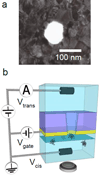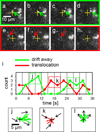DNA motion induced by electrokinetic flow near an Au coated nanopore surface as voltage controlled gate
- PMID: 25611963
- PMCID: PMC4326562
- DOI: 10.1088/0957-4484/26/6/065502
DNA motion induced by electrokinetic flow near an Au coated nanopore surface as voltage controlled gate
Abstract
We used fluorescence microscopy to investigate the diffusion and drift motion of λ DNA molecules on an Au-coated membrane surface near nanopores, prior to their translocation through solid-state nanopores. With the capability of controlling electric potential at the Au surface as a gate voltage, Vgate, the motions of DNA molecules, which are presumably generated by electrokinetic flow, vary dramatically near the nanopores in our observations. We carefully investigate these DNA motions with different values of Vgate in order to alter the densities and polarities of the counterions, which are expected to change the flow speed or direction, respectively. Depending on Vgate, our observations have revealed the critical distance from a nanopore for DNA molecules to be attracted or repelled-DNA's anisotropic and unsteady drifting motions and accumulations of DNA molecules near the nanopore entrance. Further finite element method (FEM) numerical simulations indicate that the electrokinetic flow could qualitatively explain these unusual DNA motions near metal-collated gated nanopores. Finally, we demonstrate the possibility of controlling the speed and direction of DNA motion near or through a nanopore, as in the case of recapturing a single DNA molecule multiple times with alternating current voltages on the Vgate.
Figures






Similar articles
-
Controlling DNA translocation through gate modulation of nanopore wall surface charges.ACS Nano. 2011 Jul 26;5(7):5509-18. doi: 10.1021/nn201883b. Epub 2011 Jun 17. ACS Nano. 2011. PMID: 21662982
-
Directly observing the motion of DNA molecules near solid-state nanopores.ACS Nano. 2012 Nov 27;6(11):10090-7. doi: 10.1021/nn303816w. Epub 2012 Oct 12. ACS Nano. 2012. PMID: 23046052 Free PMC article.
-
Gate-Voltage-Controlled Threading DNA into Transistor Nanopores.J Phys Chem B. 2018 Jan 18;122(2):827-833. doi: 10.1021/acs.jpcb.7b06932. Epub 2017 Oct 5. J Phys Chem B. 2018. PMID: 28893067
-
Asymmetric ion transport through ion-channel-mimetic solid-state nanopores.Acc Chem Res. 2013 Dec 17;46(12):2834-46. doi: 10.1021/ar400024p. Epub 2013 May 28. Acc Chem Res. 2013. PMID: 23713693 Review.
-
Nanotechnology and Nanopore Sequencing.Recent Pat Nanotechnol. 2017;11(1):34-41. doi: 10.2174/1872210510666160602152913. Recent Pat Nanotechnol. 2017. PMID: 27262629 Review.
Cited by
-
Gated Single-Molecule Transport in Double-Barreled Nanopores.ACS Appl Mater Interfaces. 2018 Nov 7;10(44):38621-38629. doi: 10.1021/acsami.8b13721. Epub 2018 Oct 25. ACS Appl Mater Interfaces. 2018. PMID: 30360085 Free PMC article.
-
Tailoring particle translocation via dielectrophoresis in pore channels.Sci Rep. 2016 Aug 16;6:31670. doi: 10.1038/srep31670. Sci Rep. 2016. PMID: 27527126 Free PMC article.
-
Clog and Release, and Reverse Motions of DNA in a Nanopore.Polymers (Basel). 2019 Jan 7;11(1):84. doi: 10.3390/polym11010084. Polymers (Basel). 2019. PMID: 30960068 Free PMC article.
References
-
- Li J, Stein D, McMullan C, Branton D, Aziz MJ, Golovchenko JA. Ion-beam sculpting at nanometre length scales. Nature. 2001;412:166–169. - PubMed
-
- Storm AJ, Chen JH, Ling XS, Zandbergen HW, Dekker C. Fabrication of solid-state nanopores with single-nanometre precision. Nat. Mater. 2003;2:537–540. - PubMed
-
- Stein D, Li J, Golovchenko JA. Ion-beam sculpting time scales. Phys. Rev. Lett. 2002;89:276106. - PubMed
-
- Branton D, Deamer DW, Marziali A, Bayley H, Benner SA, Butler T, Di Ventra M, Garaj S, Hibbs A, Huang X, Jovanovich SB, Krstic PS, Lindsay S, Ling XS, Mastrangelo CH, Meller A, Oliver JS, Pershin YV, Ramsey JM, Riehn R, Soni GV, Tabard-Cossa V, Wanunu M, Wiggin M, Schloss JA. The potential and challenges of nanopore sequencing. Nat. Biotechnol. 2008;26:1146–1153. - PMC - PubMed
Publication types
MeSH terms
Substances
Grants and funding
LinkOut - more resources
Full Text Sources
Other Literature Sources
